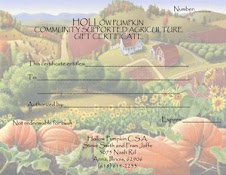
Friday, December 17, 2010
Growing Asparagus: What you may not know

The good news is: We planted 400 asparagus plants and 95% of them survived the 2010 drought. The beautiful lacy field of asparagus is happy and thriving.
We took a survey of our current membership and others this year so we could better understand the needs of the community. One of the questions was, of course, What are your favorite vegetables. One of the vegetables that showed up on many of our surveys was asparagus. Most folks don't know what it takes to grow asparagus - I know I did not before coming to the farm so I thought I'd fill you in on the skinny about asparagus.
Asparagus was originally a sea vegetable. When deciding to plant asparagus figure out if you are willing to wait about three years for the young plants to become fully mature. You may get small diameter asparagus the season after you plant, but if you harvest them you may be jeopardizing the yield of next season's harvest. Once the plants are mature, you have about an eight week opportunity to harvest the yummy vegetables, usually April and May, and that is it for the season. That may account for why asparagus is costly in the supermarkets.
If you do decide to plant asparagus, make sure you give it organic material, i.e. manure in the winter. If you do give it manure in the winter and you are growing organically, (which we hope you are), you want to watch out for the weeds. They grow like mad. Steve says that long ago, folks use to use salt to keep the weeds away. The pitfall of salt is that nothing else will grow there after that (except your asparagus because, remember, they are a sea vegetable.) the good news is, if you take care of your asparagus they will produce for about 20 years, so you may not have to plant any other crop for a while.
Asparagus need potassium. So a little wood ash is good to put on them. Any woody plant has pot ash in them which is high in potassium. By adding the wood ash to the soil you are helping to increase the potash in the plant.
So now you know about asparagus. We may break the rules and harvest some next season if it looks as though the yield will allow it. If not, our members may have to wait until the following season.
Saturday, December 11, 2010
Preparing for the New Year
 Hi,this is farmer Steve letting you know what I'm up to
Hi,this is farmer Steve letting you know what I'm up toafter the deliveries are done. Dividing rhubarb has gotten as far as new holes dug and I have decided to wait for early spring to see which plants survived the drought and only divide the live ones to set in the new holes. Thursday, a friend of the farm, Ryan Campbell and I were up in the Arkansas Black apple trees pruning away. More apples, pears, a couple of cherries and one plum to go!
This time of the year allows me to do some late season canning, pickling and perusing the numerous seed catalogues that arrive each day in the mail. Soon I will be ordering seeds for the new season.
(photo above: Arkansas Black apple tree on Hollow Pumpkin Farm)
Monday, November 8, 2010
What's In A Share?

This is an example of a half share that our C.S.A. members would get in the fall. This particular box had a beautiful head of tat soi, eggplant, arugula, sweet potatoes, salad mix and pears. We will be posting a full share example as soon as We can.
Friday, October 8, 2010
Subscribe to:
Comments (Atom)






